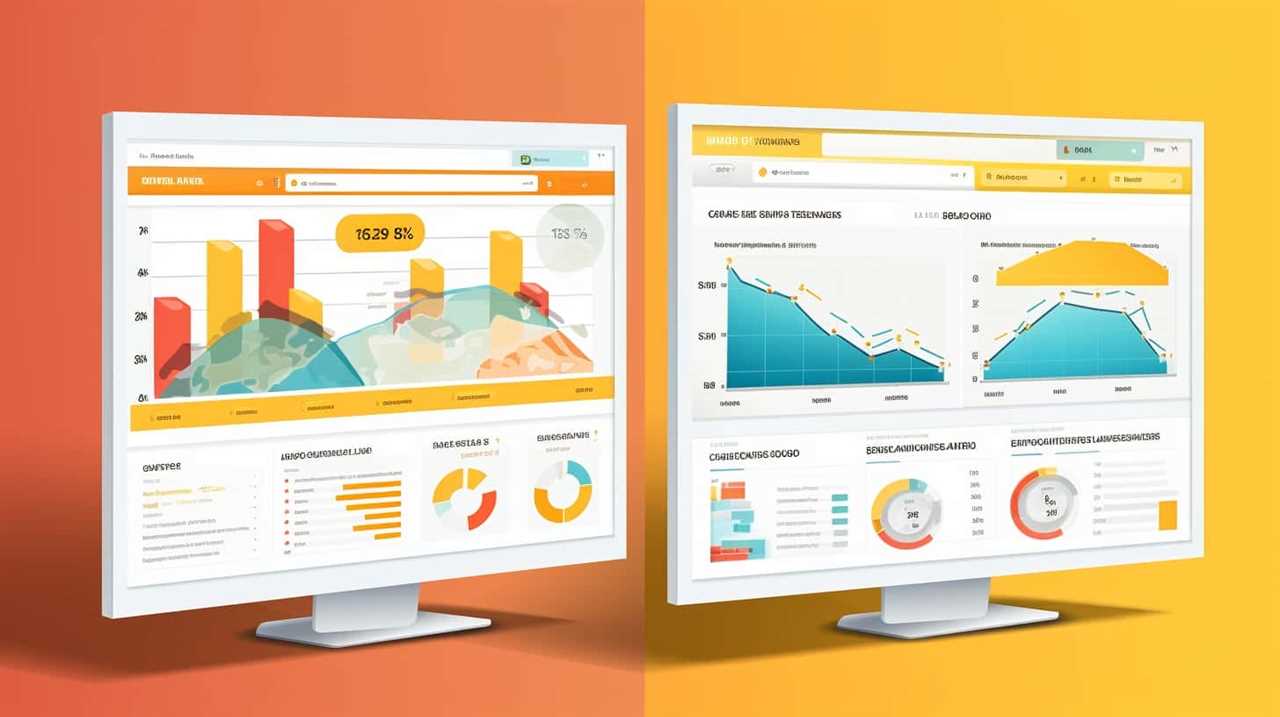Are you prepared to delve into the real influence of your target audience?
In this article, we will guide you through 15 essential steps to measure and gauge your influence.
From defining your niche market to evaluating customer retention rates, we’ll provide you with analytical insights and data-driven techniques to help you master the art of measuring impact.
Get ready to unlock the secrets behind your niche market’s true influence and take your business to the next level.

Key Takeaways
- Define your niche market and tailor your messaging to target audience analysis and market segmentation.
- Analyze competitors’ strategies and strengths to maintain a competitive edge in the niche market.
- Conduct market research to gather valuable data about the target audience and analyze customer behavior to tailor marketing strategies accordingly.
- Track website traffic and analyze online presence using website analytics tools to optimize content and improve website performance.
Define Your Niche Market
To effectively gauge niche market influence, we must first define our target audience.
Target audience analysis and market segmentation are crucial steps in understanding our niche market and determining its impact.
By conducting a thorough target audience analysis, we gain valuable insights into the demographics, psychographics, and behaviors of our potential customers. This analysis allows us to identify specific segments within our niche market and tailor our marketing strategies accordingly.
Market segmentation further helps us in categorizing our audience into smaller, more manageable groups based on common characteristics and needs.

By understanding the diverse segments within our niche market, we can develop targeted messaging, products, and services that resonate with each segment.
This approach not only enhances our influence in the niche market but also improves customer satisfaction and loyalty.
Identify Key Competitors
In identifying key competitors, we analyze the market landscape and identify the businesses or organizations that directly compete with us in our niche market. Competitor analysis is a crucial step in understanding our market position and gaining insights into the strategies and strengths of our competitors.
By examining their products, pricing, marketing tactics, and customer base, we can identify areas where we’ve a competitive advantage and areas where we may need to improve.

It’s important to stay updated on market competition trends to anticipate any shifts in the market and stay ahead of our competitors. By regularly conducting competitor analysis, we can make informed decisions and develop strategies that will help us maintain our competitive edge in the niche market.
Conduct Market Research
As we delve into measuring niche market influence, it is essential that we begin by conducting market research. Market research allows us to gather valuable data and insights about our target audience and competitors, enabling us to make informed decisions and develop effective strategies. There are various market segmentation techniques that can be used to divide our target market into distinct groups based on demographics, psychographics, and behavior. This helps us tailor our marketing efforts to specific customer segments, maximizing our impact and return on investment. Additionally, conducting competitive analysis strategies allows us to understand the strengths and weaknesses of our competitors, identify market trends, and uncover opportunities for differentiation. By combining market segmentation techniques with competitive analysis strategies, we can gain a comprehensive understanding of our niche market and make strategic decisions that drive success.
| Market Segmentation Techniques | Competitive Analysis Strategies |
|---|---|
| Demographics: Divide market based on age, gender, income, etc. | Identify key competitors and analyze their strengths and weaknesses |
| Psychographics: Segment market based on attitudes, values, interests | Monitor market trends and identify emerging opportunities |
| Behavior: Categorize market based on purchasing behavior, usage patterns | Analyze competitor pricing, product offerings, and marketing strategies |
| Geographics: Divide market based on geographic location | Assess competitor market share and customer satisfaction levels |
Analyze Customer Behavior
We study customer behavior to gain insights into their preferences and purchasing patterns. Analyzing customer behavior allows us to understand how different segments of customers behave and make purchase decisions.
Customer segmentation is a key aspect of this analysis, as it helps us group customers based on various factors such as demographics, psychographics, and buying behavior. By segmenting customers, we can identify patterns and trends that can inform our marketing strategies and improve our understanding of their needs and wants.

Additionally, purchase behavior analysis helps us track customers’ buying habits, such as the frequency of purchases, average order value, and product preferences. This data-driven approach enables us to tailor our offerings and marketing messages to better meet the needs of our customers, ultimately driving higher customer satisfaction and loyalty.
Track Website Traffic
To gauge niche market influence, we track website traffic. Website analytics and traffic analysis provide valuable insights into the effectiveness of our online presence. Here are four key steps we take to measure and analyze website traffic:
- Implementing website analytics tools: We utilize robust analytics platforms like Google Analytics to track and measure various metrics, such as the number of visitors, page views, and bounce rates.
- Setting up goals and conversions: By defining specific goals, such as newsletter sign-ups or purchases, we can track and measure the success of our website in driving desired actions.
- Examining traffic sources: We analyze the different channels through which visitors arrive at our website, including organic search, social media, and referral traffic, to understand which sources are driving the most engagement.
- Monitoring user behavior: We track user behavior on our website, including the pages they visit, the time spent on each page, and the actions they take, to gain insights into user preferences and optimize our content accordingly.
Monitor Social Media Engagement
One important step is to regularly monitor social media engagement analytics to assess our impact in the niche market. By keeping a close eye on social media analytics and engagement metrics, we can gain valuable insights into how our brand is perceived and how effectively we are connecting with our target audience.
To effectively monitor social media engagement, it is crucial to focus on key metrics such as likes, comments, shares, and follower growth. These metrics can provide a snapshot of our reach and engagement levels across different social media platforms.

To illustrate the importance of monitoring social media engagement, consider the following table:
| Social Media Platform | Likes | Comments | Shares |
|---|---|---|---|
| 500 | 100 | 200 | |
| 800 | 150 | 300 | |
| 400 | 80 | 150 |
This table showcases the engagement metrics for our brand across different social media platforms. By regularly analyzing and comparing these metrics, we can identify trends, determine the effectiveness of our content strategies, and make data-driven decisions to optimize our social media presence.
Measure Brand Awareness
By analyzing brand recognition and recall, we can accurately measure the level of brand awareness within our niche market. This is crucial in understanding how well our brand is known and remembered by our target audience.
To measure brand awareness effectively, we should consider the following:

- Conduct surveys or interviews to gauge brand recognition among our target customers.
- Track website traffic and analyze how many visitors are coming to our site directly or through branded search terms.
- Monitor social media mentions and engagement related to our brand.
- Measure customer loyalty through repeat purchases and referral rates.
Assess Customer Satisfaction
When it comes to assessing customer satisfaction, there are two crucial aspects to consider: feedback collection methods and improving the overall customer experience.
Feedback collection methods allow us to gather valuable insights from our customers, helping us understand their needs and preferences. By actively seeking and listening to customer feedback, we can identify areas for improvement and make informed decisions to enhance their experience.
Ultimately, the goal is to ensure that our customers are satisfied and have a positive perception of our brand.
Feedback Collection Methods
We regularly gather feedback from our customers to gauge their satisfaction levels and continuously improve our products and services. To ensure accurate and comprehensive user feedback, we employ various survey methods that provide valuable insights. Here are four effective feedback collection methods we utilize:

- Online Surveys: We create and distribute online surveys using platforms like SurveyMonkey or Google Forms. These surveys allow us to gather quantitative and qualitative data from a large number of customers.
- In-app Feedback: We integrate feedback forms directly into our applications, making it easy for users to share their thoughts and suggestions while using our products.
- Social Media Listening: We monitor social media platforms to understand how customers are discussing and interacting with our brand. This method helps us identify trends and address any issues or concerns in real-time.
- Customer Interviews: We conduct one-on-one interviews with selected customers to gain deeper insights into their experiences, preferences, and pain points.
Improving Customer Experience
To enhance the customer experience and assess their satisfaction, we rely on various methods of feedback collection. Improving customer loyalty and enhancing customer satisfaction are crucial aspects of any business.
It’s essential to understand how customers feel about their overall experience and identify areas for improvement. One effective way to measure customer satisfaction is through surveys and questionnaires. These tools allow us to gather valuable insights and identify trends or patterns in customer feedback.
Additionally, analyzing customer reviews and feedback on social media platforms can provide valuable information about their experiences and preferences. By actively listening to our customers and addressing their concerns promptly, we can enhance their satisfaction and build stronger relationships.
This will ultimately lead to improved customer loyalty and greater success for our business.

Evaluate Industry Partnerships
When it comes to evaluating industry partnerships, it’s crucial to assess their effectiveness and measure their impact. By analyzing key metrics and data, we can determine the success of these partnerships and identify areas for improvement.
This evaluation process allows us to make data-driven decisions and ensure that our partnerships are contributing to our overall niche market influence.
Evaluating Partnership Effectiveness
Evaluating industry partnerships is crucial for measuring the effectiveness of collaborations in the niche market. To accurately assess the success of a partnership and calculate the return on investment (ROI), the following steps should be taken:
- Define clear objectives: Clearly define the goals and objectives of the partnership to align expectations and facilitate evaluation.
- Establish measurable metrics: Identify key performance indicators (KPIs) that can provide quantitative data to assess the partnership’s impact.
- Collect and analyze data: Gather relevant data on the partnership’s activities and outcomes, and analyze it to gain actionable insights.
- Seek feedback from stakeholders: Engage with partners, customers, and other stakeholders to gather qualitative feedback and understand their perceptions.
By following these steps, businesses can evaluate collaboration success and measure partnership ROI effectively.

This evaluation process enables informed decision-making and continuous improvement, ultimately contributing to the growth and success of the niche market.
Measuring Partnership Impact
In assessing the impact of industry partnerships, we rely on the data collected and analyzed to measure their effectiveness. To measure collaboration success and assess partnership value, we need to consider several key factors.
Firstly, we must evaluate the alignment of goals between the partners and the extent to which these goals have been achieved. This can be measured through metrics such as revenue growth, market share, or customer satisfaction.
Additionally, the level of trust and communication within the partnership should be assessed, as strong relationships often lead to better outcomes.

Moreover, the impact on the industry as a whole should be considered, including any positive changes or innovations that have resulted from the collaboration.
By analyzing these factors, we can gain valuable insights into the true value and impact of industry partnerships.
Transition: Now that we’ve discussed measuring partnership impact, let’s move on to analyzing influencer collaborations.
Analyze Influencer Collaborations
To assess the impact of influencer collaborations, we analyze key metrics and engagement data. By conducting a thorough collaboration analysis, we can gain valuable insights into the effectiveness of influencer marketing campaigns.

Here are four important steps to consider:
- Identify the goals: Clearly define the objectives of the collaboration, such as increasing brand awareness, driving sales, or reaching a specific target audience.
- Measure reach and impressions: Evaluate the number of followers, views, and impressions generated by the influencer’s content to determine the campaign’s reach.
- Assess engagement: Analyze the level of interaction and engagement with the influencer’s content, including likes, comments, shares, and click-through rates.
- Track conversions: Monitor the number of conversions, such as purchases or sign-ups, directly attributable to the influencer collaboration.
Monitor Online Reviews and Ratings
We regularly monitor online reviews and ratings to assess the impact of influencer collaborations. This practice is crucial for effective online reputation management and provides valuable insights into customer sentiment and satisfaction.
By analyzing customer reviews, we can identify patterns, trends, and areas for improvement, enabling us to make data-driven decisions that enhance our niche market influence. Customer review analysis allows us to gauge the effectiveness of influencer collaborations by measuring the impact they’ve on our brand’s reputation and customer perception.
We pay close attention to the sentiments expressed in reviews, looking for positive feedback and addressing any negative experiences promptly. This proactive approach to online reputation management helps us maintain a positive brand image, build customer loyalty, and ultimately, drive business growth.

Track Keyword Rankings
Continuing our analysis of influencer collaborations, we track keyword rankings to gauge our niche market influence. Keyword analysis is a crucial aspect of our SEO strategies, allowing us to measure the effectiveness of our content and optimize our website for search engines.
Here are four key points to consider when tracking keyword rankings:
- Identify target keywords: We start by selecting relevant keywords that align with our niche market and reflect the intent of our audience.
- Monitor rankings: We use SEO tools to track our keyword rankings on search engine result pages (SERPs) and analyze any fluctuations or trends.
- Analyze competition: We compare our rankings with competitors to gain insights into their SEO strategies and identify areas for improvement.
- Adapt and optimize: By regularly monitoring keyword rankings, we can make data-driven decisions to refine our content and SEO tactics for better visibility and increased niche market influence.
Tracking keyword rankings provides valuable insights and helps us stay ahead in our niche market. By leveraging the power of keyword analysis and implementing effective SEO strategies, we can enhance our online presence and attract a wider audience.
Measure Email Marketing Effectiveness
When measuring email marketing effectiveness, there are several key points to consider.

First, analyzing click-through rates provides insight into how engaging and enticing the email content is to recipients.
Second, tracking conversion rates allows us to measure the actual impact of the email campaign in terms of driving desired actions.
Lastly, A/B testing can help determine the effectiveness of different email strategies and optimize future campaigns for better results.
Click-Through Rates Analysis
To measure the effectiveness of email marketing, we can analyze the click-through rates. Click-through rates (CTRs) provide valuable insights into how well your email campaigns are performing.

Here are some key steps to consider when conducting a click-through rates analysis:
- Benchmarking: Compare your CTRs against industry standards to determine how well your campaigns are performing in comparison to your competitors.
- Segmentation: Analyze CTRs for different segments of your email list to identify which segments are responding better to your campaigns.
- Optimization: Identify areas where CTRs are low and implement strategies to optimize your email content and design to improve engagement.
- A/B Testing: Conduct A/B tests with different subject lines, call-to-action buttons, or email layouts to determine which elements drive higher CTRs.
Conversion Rate Tracking
We can further evaluate the effectiveness of our email marketing campaigns by tracking the conversion rates, which allows us to measure the impact of our efforts on driving desired actions from our audience.
Conversion rate tracking is a crucial component of conversion rate optimization, as it helps us understand how well our emails are converting recipients into customers or taking other desired actions, such as signing up for a newsletter or making a purchase.
By analyzing conversion rates, we can identify areas of improvement and make data-driven decisions to enhance our email marketing strategy.

Additionally, conversion rate tracking can be complemented by website usability analysis, which helps us identify any barriers or friction points that may be hindering conversions.
By optimizing both our email campaigns and website usability, we can maximize the effectiveness of our email marketing efforts and drive better results.
Now, let’s move on to discuss the effectiveness of a/b testing in improving conversion rates.
A/B Testing Effectiveness
To measure the effectiveness of our email marketing campaigns, we can assess the impact of A/B testing on improving conversion rates. A/B testing analysis allows us to compare two or more versions of an email to determine which one performs better.

Here’s how we can effectively measure the impact of A/B testing on our conversion rates:
- Identify the key elements to test, such as subject lines, call-to-action buttons, or email designs.
- Split our email list into two or more segments and randomly assign each segment to receive a different version of the email.
- Track the conversion rates of each segment to determine which version generates better results.
- Analyze the data collected to draw insights and make informed decisions on future email marketing strategies.
Assess Sales and Revenue Growth
By analyzing sales and revenue growth, we can gain valuable insights into the impact of our niche market influence. Assessing market demand and evaluating our pricing strategy are crucial components in understanding our market position and overall performance. To effectively measure our sales and revenue growth, we should consider several key metrics, such as the number of units sold, average order value, customer lifetime value, and revenue growth rate. These metrics provide us with quantitative data to evaluate the effectiveness of our marketing efforts and pricing strategy. By closely monitoring these metrics over time, we can identify trends, make informed decisions, and optimize our approach to maximize profitability and market impact. The table below highlights the importance of each metric and their corresponding insights:
| Metric | Importance | Insights |
|---|---|---|
| Number of units sold | Indicates product demand | Increasing sales volume suggests a growing customer base and popular products. |
| Average order value | Reflects pricing strategy and customer purchasing behavior | Higher average order values may indicate successful upselling or premium product positioning. |
| Customer lifetime value | Measures customer loyalty and revenue potential over the long term | Increasing customer lifetime value suggests strong customer retention and potential for repeat purchases. |
| Revenue growth rate | Demonstrates overall business growth and effectiveness of marketing efforts | Consistent revenue growth indicates successful market penetration and strong demand for products or services. |
Analyzing these metrics collectively allows us to assess our sales and revenue growth comprehensively, providing actionable insights for improving our niche market influence.
Evaluate Customer Retention Rates
Assessing customer retention rates allows us to understand the long-term loyalty and satisfaction of our customers, providing valuable insights into the effectiveness of our niche market influence. By conducting customer churn analysis and evaluating customer loyalty programs, we can gain a comprehensive view of how well we’re retaining our customers and keeping them engaged.

Here are some key considerations when evaluating customer retention rates:
- Analyzing churn rates: By measuring the percentage of customers who leave over a given period, we can identify any potential issues or areas for improvement in our product or service offerings.
- Tracking customer lifetime value: Understanding the value that each customer brings over their lifetime allows us to prioritize efforts to retain high-value customers and allocate resources effectively.
- Assessing customer satisfaction: Regularly surveying customers and monitoring their satisfaction levels helps us gauge the effectiveness of our customer loyalty programs and identify areas for improvement.
- Benchmarking against competitors: Comparing our customer retention rates with industry benchmarks allows us to assess our performance and identify opportunities to differentiate ourselves in the market.
Frequently Asked Questions
How Can I Effectively Measure the Impact of My Email Marketing Campaigns?
To effectively measure the impact of our email marketing campaigns, we need to evaluate our email campaign impact and assess our email marketing success. This requires analyzing data, tracking key metrics, and making data-driven decisions to optimize our campaigns.
What Are Some Strategies for Assessing and Improving Customer Retention Rates?
Assessing and improving customer retention rates is crucial for business success. By analyzing data, implementing personalized strategies, and enhancing customer satisfaction, we can optimize loyalty and drive long-term growth.
Are There Any Specific Metrics or Tools That Can Help Evaluate the Effectiveness of Industry Partnerships?
Metrics and evaluation tools are essential in assessing the effectiveness of industry partnerships. By measuring key performance indicators and utilizing data-driven analysis, we can gain valuable insights into the impact and success of these collaborations.

How Can I Track and Analyze Sales and Revenue Growth in My Niche Market?
To track sales and analyze revenue growth in our niche market, we utilize various metrics and tools. By closely monitoring sales data, analyzing market trends, and conducting thorough customer surveys, we gain valuable insights for strategic decision-making.
What Are Some Key Indicators to Consider When Measuring Brand Awareness in a Niche Market?
When measuring brand awareness in a niche market, key indicators to consider are brand recognition and market penetration. These metrics provide valuable insights into how well your brand is known and how deeply it has penetrated the target market.
Conclusion
In the symphony of niche market influence, measuring impact requires a meticulous dance between data and analysis.
By defining our niche market, identifying competitors, and conducting thorough research, we unlock the key to understanding customer behavior.

Tracking website traffic and keyword rankings provide a harmonious melody of insight, while measuring email marketing effectiveness and assessing sales growth add depth to our composition.
Finally, evaluating customer retention rates completes our masterpiece, leaving us with a symphony of data-driven insights and a clear path towards success.










